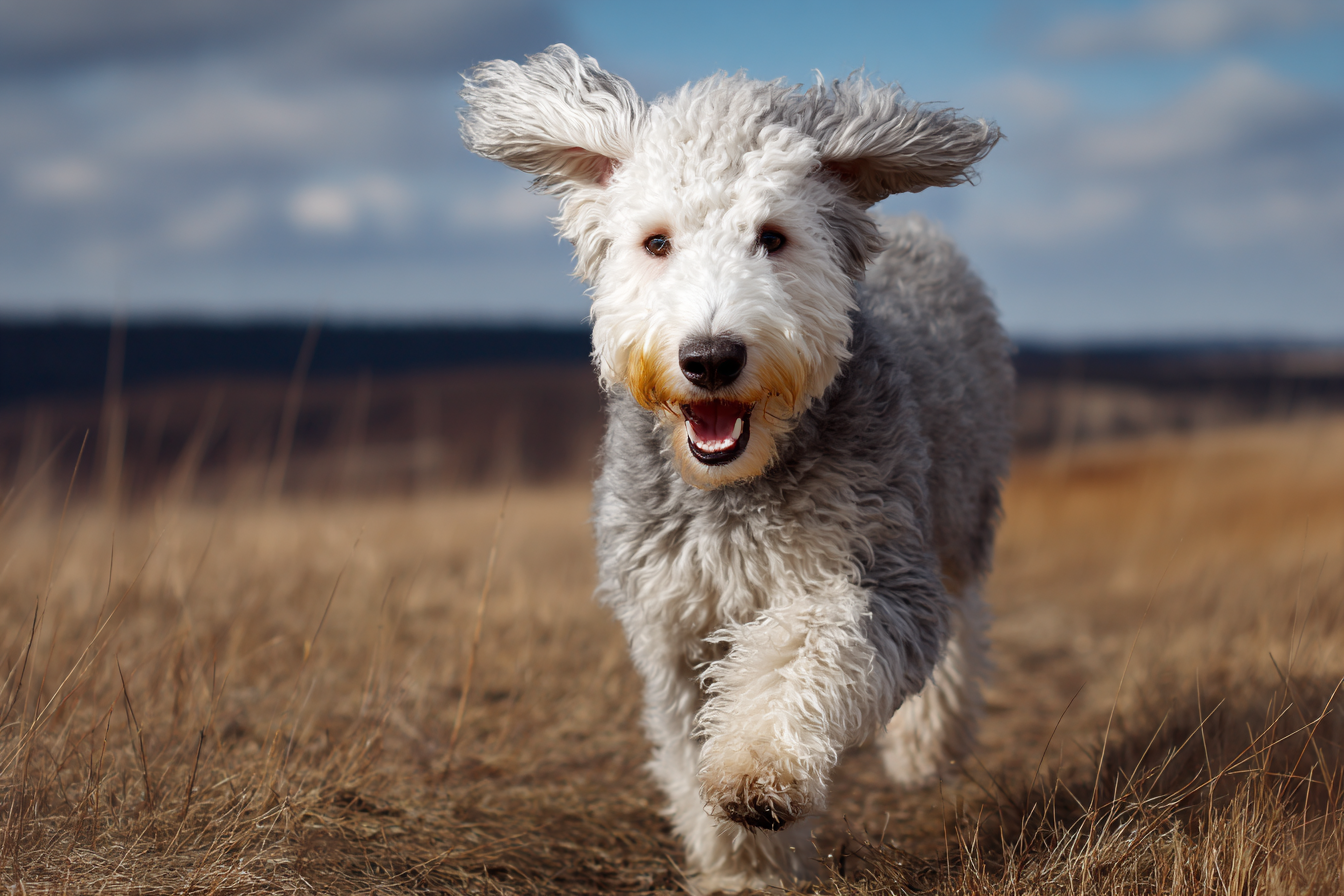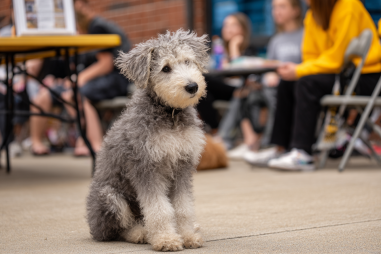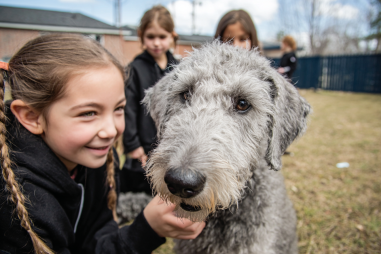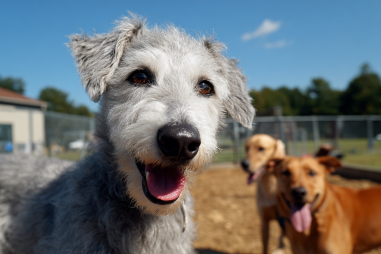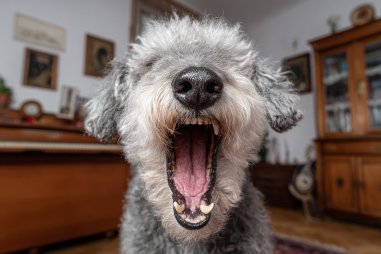Bedlington Terriers are unique, lively companions with a distinct lamb-like appearance and a spirited personality. Known for their agility and friendly nature, these dogs thrive on a balanced routine that combines physical exercise and mental stimulation. Understanding their exercise requirements is key to ensuring your Bedlington Terrier remains healthy, happy, and well-behaved. In this article, we’ll explore their activity levels, daily exercise needs, suitable physical activities and games, differences between exercising puppies and adult dogs, the role of mental stimulation, and how to recognize signs of improper exercise. Let’s dive in!
Activity Level of Bedlington Terriers
Bedlington Terriers are moderately active dogs that enjoy spending time on the move. Originally bred for hunting vermin, they have a natural instinct to be alert and energetic. However, unlike some high-energy breeds such as Border Collies or Jack Russell Terriers, Bedlingtons maintain a steady activity level — playful and lively, but not overly hyperactive. This makes them excellent companions for families and individuals who want a dog that enjoys daily activity without demanding constant attention or excessive exercise.
Their energy levels mean that they do need sufficient daily exercise to channel their natural drive. Without enough activity, Bedlington Terriers may become bored, which can lead to undesirable behaviors like chewing, digging, or excessive barking. At the same time, they are usually content to relax after their daily exercise, striking a nice balance between activity and calmness.
Daily Exercise Recommendations
Exercise is essential for maintaining your Bedlington Terrier’s physical health and emotional well-being. Generally, these dogs require around 45 minutes to 1 hour of moderate exercise each day to stay fit and satisfied. This can be split into two or three sessions, making it easier to fit into your schedule and helping to prevent overexertion.
Walking is one of the best and simplest ways to meet their daily exercise needs. A brisk 30 to 40-minute walk in the morning, followed by a shorter walk or play session in the evening, usually suffices. Apart from walks, incorporating playtime and interactive activities is beneficial to keep them mentally engaged and physically active.
Consistency is key — regular daily exercise supports better health, helps regulate their weight, and alleviates stress. Avoid long, intense sessions that could overwhelm the dog, especially if they are not accustomed to such activity or have health issues.
Types of Physical Activities and Games
Bedlington Terriers are versatile and enjoy a variety of physical activities and games that engage both their bodies and minds. Here are some popular options:
- Walking and Hiking: Daily walks are a staple, but if you want to add variety, gentle hikes over uneven terrain can provide a good workout and new sights and smells.
- Fetch: This classic game is fantastic for burning energy and enhancing the dog’s natural retrieving instincts.
- Agility Training: Bedlingtons are agile and quick learners, making agility courses an excellent way to combine mental and physical challenge.
- Interactive Toys: Toys that dispense treats or require problem-solving keep the dog moving and thinking simultaneously.
- Off-leash Play: In safe, enclosed areas, letting your Bedlington Terrier run and explore freely helps satisfy their hunting and chasing drives.
Remember to tailor activities according to your individual dog’s fitness level and preferences. Regularly switching up games can boost enthusiasm and prevent boredom.
Exercise for Puppies vs. Adult Dogs
Exercise needs change as your Bedlington Terrier grows. Puppies, with their developing bones and joints, require gentler and shorter bursts of activity compared to adults. Their play sessions should be frequent but limited to prevent physical strain or injury. Additionally, puppies benefit greatly from socialization during exercise, helping them get comfortable with other dogs, people, and environments.
For Bedlington Terrier puppies, short walks of about 10-15 minutes several times a day combined with supervised play are ideal. Avoid high-impact activities like jumping from heights or prolonged running until they have matured physically.
Adult dogs can handle longer, more structured exercise but still need to avoid excessive hard running and jumping. Senior Bedlingtons may also require reduced intensity and duration based on their health and mobility.
Mental Stimulation Combined With Physical Activity
Physical exercise is only part of the puzzle. Bedlington Terriers are intelligent and inquisitive dogs that thrive on mental stimulation. When exercise incorporates mental challenges, it becomes even more beneficial for overall well-being.
Activities like training sessions, puzzle toys, scent work, or interactive games sharpen your dog’s mind while simultaneously encouraging movement. Teaching new commands or tricks during walk breaks can boost mental engagement and improve your bond.
Some examples of mentally stimulating combined activities you can try include:
- Hide and Seek: Hide treats or toys around a safe area and encourage your dog to find them.
- Obstacle Courses: Create simple indoor or outdoor courses that require problem-solving as well as physical movement.
- Scent Tracking: Hide objects with scents and let your Bedlington follow the trail.
Providing this holistic blend of activity nurtures a happy, healthy, and well-rounded Bedlington Terrier.
Signs of Over or Under-Exercising
Monitoring your Bedlington Terrier’s response to exercise is vital to maintaining their health and preventing injury or behavioral problems. Some tell-tale signs can indicate if your dog is not receiving the right amount of physical activity:
- Signs of Under-Exercising:
- Restlessness or hyperactivity around the house
- Destructive behaviors such as chewing furniture or shoes
- Excessive barking or whining
- Weight gain or obesity
- Increased anxiety or depression-like symptoms
- Signs of Over-Exercising:
- Limping, stiffness, or signs of pain after activity
- Excessive panting or difficulty breathing
- Reluctance to move or obvious fatigue
- Muscle soreness or swelling
- Behavioral changes like irritability or withdrawal
If you notice any of these signs, adjust the length or intensity of exercise accordingly and consult a veterinarian if problems persist. It’s always better to err on the side of moderation, especially when trying new types of activities or routines.
Keeping Your Bedlington Terrier Happy and Healthy
By understanding and meeting your Bedlington Terrier’s exercise requirements, you are helping to ensure a long, joyful life for your furry friend. Balancing daily walks, playtime, and mental challenges keeps their body strong and their mind sharp. Remember to adjust the routine according to age, health, and energy levels, and listen to your dog’s cues for when to push harder or take it easy.
With love, attention, and proper exercise, your Bedlington Terrier will remain a loyal, content, and vibrant companion through every stage of life.

